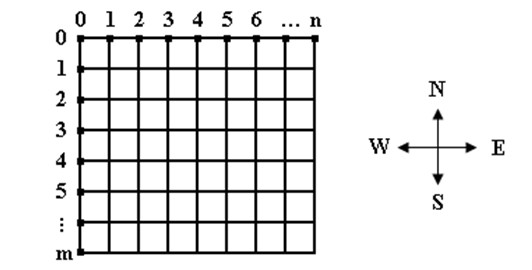HDU3533:Escape(BFS) (D)
来源:互联网 发布:常见协议端口号 编辑:程序博客网 时间:2024/05/20 05:55
转自:http://blog.csdn.net/libin56842/article/details/41909459
Problem Description
Problem Description
The students of the HEU are maneuvering for their military training.
The red army and the blue army are at war today. The blue army finds that Little A is the spy of the red army, so Little A has to escape from the headquarters of the blue army to that of the red army. The battle field is a rectangle of size m*n, and the headquarters of the blue army and the red army are placed at (0, 0) and (m, n), respectively, which means that Little A will go from (0, 0) to (m, n). The picture below denotes the shape of the battle field and the notation of directions that we will use later.

The blue army is eager to revenge, so it tries its best to kill Little A during his escape. The blue army places many castles, which will shoot to a fixed direction periodically. It costs Little A one unit of energy per second, whether he moves or not. If he uses up all his energy or gets shot at sometime, then he fails. Little A can move north, south, east or west, one unit per second. Note he may stay at times in order not to be shot.
To simplify the problem, let’s assume that Little A cannot stop in the middle of a second. He will neither get shot nor block the bullet during his move, which means that a bullet can only kill Little A at positions with integer coordinates. Consider the example below. The bullet moves from (0, 3) to (0, 0) at the speed of 3 units per second, and Little A moves from (0, 0) to (0, 1) at the speed of 1 unit per second. Then Little A is not killed. But if the bullet moves 2 units per second in the above example, Little A will be killed at (0, 1).
Now, please tell Little A whether he can escape.
The red army and the blue army are at war today. The blue army finds that Little A is the spy of the red army, so Little A has to escape from the headquarters of the blue army to that of the red army. The battle field is a rectangle of size m*n, and the headquarters of the blue army and the red army are placed at (0, 0) and (m, n), respectively, which means that Little A will go from (0, 0) to (m, n). The picture below denotes the shape of the battle field and the notation of directions that we will use later.

The blue army is eager to revenge, so it tries its best to kill Little A during his escape. The blue army places many castles, which will shoot to a fixed direction periodically. It costs Little A one unit of energy per second, whether he moves or not. If he uses up all his energy or gets shot at sometime, then he fails. Little A can move north, south, east or west, one unit per second. Note he may stay at times in order not to be shot.
To simplify the problem, let’s assume that Little A cannot stop in the middle of a second. He will neither get shot nor block the bullet during his move, which means that a bullet can only kill Little A at positions with integer coordinates. Consider the example below. The bullet moves from (0, 3) to (0, 0) at the speed of 3 units per second, and Little A moves from (0, 0) to (0, 1) at the speed of 1 unit per second. Then Little A is not killed. But if the bullet moves 2 units per second in the above example, Little A will be killed at (0, 1).
Now, please tell Little A whether he can escape.
Input
For every test case, the first line has four integers, m, n, k and d (2<=m, n<=100, 0<=k<=100, m+ n<=d<=1000). m and n are the size of the battle ground, k is the number of castles and d is the units of energy Little A initially has. The next k lines describe the castles each. Each line contains a character c and four integers, t, v, x and y. Here c is ‘N’, ‘S’, ‘E’ or ‘W’ giving the direction to which the castle shoots, t is the period, v is the velocity of the bullets shot (i.e. units passed per second), and (x, y) is the location of the castle. Here we suppose that if a castle is shot by other castles, it will block others’ shots but will NOT be destroyed. And two bullets will pass each other without affecting their directions and velocities.
All castles begin to shoot when Little A starts to escape.
Proceed to the end of file.
All castles begin to shoot when Little A starts to escape.
Proceed to the end of file.
Output
If Little A can escape, print the minimum time required in seconds on a single line. Otherwise print “Bad luck!” without quotes.
Sample Input
4 4 3 10N 1 1 1 1W 1 1 3 2W 2 1 2 44 4 3 10N 1 1 1 1W 1 1 3 2W 1 1 2 4
Sample Output
题意:
一个人从(0,0)跑到(n,m),只有k点能量,一秒消耗一点,在图中有k个炮塔,给出炮塔的射击方向c,射击间隔t,子弹速度v,坐标x,y
问这个人能不能安全到达终点
要求:
1.人不能到达炮塔所在的坐标
2.炮塔会挡住子弹
3.途中遇到子弹是安全的,但是人如果停在这个坐标,而子弹也刚好到这个坐标,人就被射死
4.人可以选择停止不动
思路:
其实不难,我们只需要看当人位于某个点的时候,其四个方向是否有炮塔,这个炮塔是都向人的方向射击,然后再看子弹是否刚好位于这个坐标即可。
而标记的话,vis[x][y][time],对于time时刻,人位于x,y的情况只需要访问一次,这是唯一的
9Bad luck!题意:
一个人从(0,0)跑到(n,m),只有k点能量,一秒消耗一点,在图中有k个炮塔,给出炮塔的射击方向c,射击间隔t,子弹速度v,坐标x,y
问这个人能不能安全到达终点
要求:
1.人不能到达炮塔所在的坐标
2.炮塔会挡住子弹
3.途中遇到子弹是安全的,但是人如果停在这个坐标,而子弹也刚好到这个坐标,人就被射死
4.人可以选择停止不动
思路:
其实不难,我们只需要看当人位于某个点的时候,其四个方向是否有炮塔,这个炮塔是都向人的方向射击,然后再看子弹是否刚好位于这个坐标即可。
而标记的话,vis[x][y][time],对于time时刻,人位于x,y的情况只需要访问一次,这是唯一的
#include<stdio.h>#include<string.h>#include<cstring>#include<math.h>#include<queue>#include<stack>#include<algorithm>using namespace std;int n,m,k,life;int go[5][2]={0,0,0,1,0,-1,1,0,-1,0};//四个方向加一个不动int maps[105][105];bool vis[105][105][1005];//vis[x][y][time],对于time时刻,人位于x,y的情况只需要访问一次,这是唯一的struct period//记录炮台{char c;//方向int v,t;//速度和周期}s[105][105];struct node//记录人{int x,y,step;//坐标 以及走到该点需要多少时间};void bfs(){node a,next;queue<node>q;int flag,dis,tim;//dis距离差 tim时间差a.x=a.y=a.step=0;q.push(a);vis[0][0][0]=true;while(!q.empty()){a=q.front();q.pop();if(a.step>life)break; //能量耗尽if(a.x==n&&a.y==m)//到达目的地{printf("%d\n",a.step);return ;}for(int i=0;i<5;i++){next=a;next.x+=go[i][0];next.y+=go[i][1];next.step++;if(next.x<0||next.x>n||next.y<0||next.y>m)continue;if(!s[next.x][next.y].t && !vis[next.x][next.y][next.step] && next.step<=life)//在符合条件的情况下,枚举四个方向//s[next.x][next.y].t==0时说明这个点没有炮台{flag=1;//标记有没有被子弹打中for(int j=next.x-1;j>=0;j--)//往北边找炮台 找往南边射的{if(s[j][next.y].t &&s[j][next.y].c=='S'){dis=next.x-j;//人与炮台的距离if(dis%s[j][next.y].v)break;//距离不能被速度整除的话 永远不可能达到该点tim=next.step-dis/s[j][next.y].v;if(tim<0)break;//到达时第一颗子弹都没到 那么肯定不会打中if(tim%s[j][next.y].t==0)//间隔时间除以周期 整除的话 代表会被后面的子弹打中{flag=0;//标记 其他方向都不用试了break;}}if(s[j][next.y].t)break;}if(!flag)continue;for(int j=next.x+1;j<=n;j++)//往南边边找炮台 找往北边射的{if(s[j][next.y].t &&s[j][next.y].c=='N'){dis=j-next.x;//人与炮台的距离if(dis%s[j][next.y].v)break;//距离不能被速度整除的话 永远不可能达到该点tim=next.step-dis/s[j][next.y].v;if(tim<0)break;//到达时第一颗子弹都没到 那么肯定不会打中if(tim%s[j][next.y].t==0)//间隔时间除以周期 整除的话 代表会被后面的子弹打中{flag=0;//标记 其他方向都不用试了break;}}if(s[j][next.y].t)break;}if(!flag)continue;for(int j=next.y-1;j>=0;j--)//往西边边找炮台 找往东边射的{if(s[next.x][j].t &&s[next.x][j].c=='E'){dis=next.y-j;//人与炮台的距离if(dis%s[next.x][j].v)break;//距离不能被速度整除的话 永远不可能达到该点tim=next.step-dis/s[next.x][j].v;if(tim<0)break;//到达时第一颗子弹都没到 那么肯定不会打中if(tim%s[next.x][j].t==0)//间隔时间除以周期 整除的话 代表会被后面的子弹打中{flag=0;//标记 其他方向都不用试了break;}}if(s[next.x][j].t)break;}if(!flag)continue;for(int j=next.y+1;j<=m;j++)//往东边边找炮台 找往西边射的{if(s[next.x][j].t &&s[next.x][j].c=='W'){dis=j-next.y;//人与炮台的距离if(dis%s[next.x][j].v)break;//距离不能被速度整除的话 永远不可能达到该点tim=next.step-dis/s[next.x][j].v;if(tim<0)break;//到达时第一颗子弹都没到 那么肯定不会打中if(tim%s[next.x][j].t==0)//间隔时间除以周期 整除的话 代表会被后面的子弹打中{flag=0;//标记 其他方向都不用试了break;}}if(s[next.x][j].t)break;}if(!flag)continue;vis[next.x][next.y][next.step] = true;//四个方向判断都不会被子弹打中 则则将该步加入到队列中去 q.push(next);}}} printf("Bad luck!\n");}int main(){char str[3];int x,y,t,v;while(~scanf("%d%d%d%d",&n,&m,&k,&life)){memset(s,0,sizeof s);memset(vis,0,sizeof vis);for(int i=0;i<k;i++){scanf("%s%d%d%d%d",str,&t,&v,&x,&y);s[x][y].t=t;s[x][y].v=v;s[x][y].c=str[0];}bfs();}return 0;}阅读全文
0 0
- HDU3533:Escape(BFS) (D)
- HDU3533:Escape(BFS)
- HDU3533 - Escape
- HDU3533 Escape —— BFS / A*算法 + 预处理
- HDU3533 Escape (搜索)
- FZU escape(两个bfs)
- HDU 3533 Escape(BFS)
- 【HDU 3533】Escape(BFS)
- FZU 2196 Escape(两次BFS)
- Escape from Enemy Territory(二分+bfs)
- HDU - 3533----Escape(BFS+预处理)
- BFS广度优先搜索(13)--hdu3533(能力题)
- FZU 2196 Escape(BFS预处理+BFS搜索)
- BFS-hdu-3533-Escape
- HDOJ 2364 Escape (bfs)
- hdoj 2364 Escape(BFS)
- HDU-3533-Escape(BFS)
- hdu Escape(bfs+模拟)
- 第一场个人训练赛——E-成绩转换(HDU 2004)
- 反转链表(在原链表进行操作,不开辟新空间. O(N)
- C++学习笔记-模板
- oracle创建外键约束的两种方式
- JAVA配置JDK(Java SE Development Kit)
- HDU3533:Escape(BFS) (D)
- 1010. Radix (25)
- POJ 2109
- 拆分窗口
- InteliJ IDEA快捷键
- SDUT 2553 完美的素数
- VScode 使用问题记录
- JavaScript继承基础讲解
- Spotfire经验总结—累积百分比(柏拉图)的绘制方法


